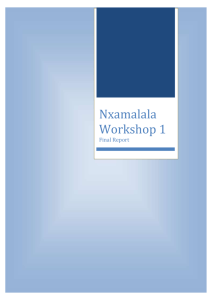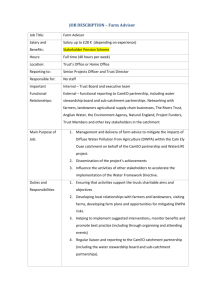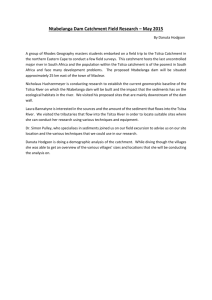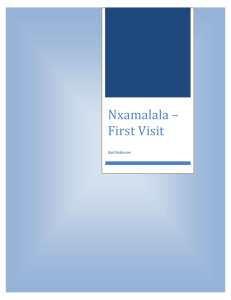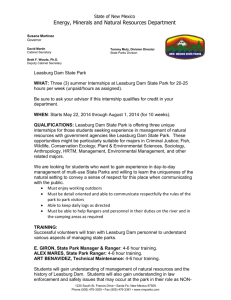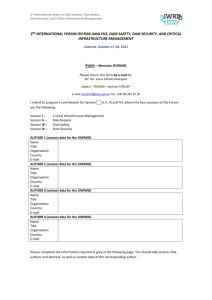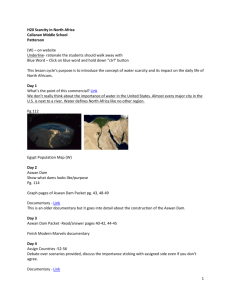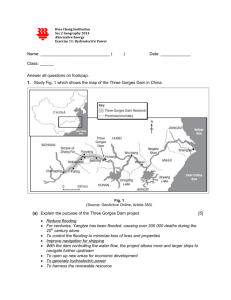Nxamalala Workshop 1 Revised Proceedings
advertisement
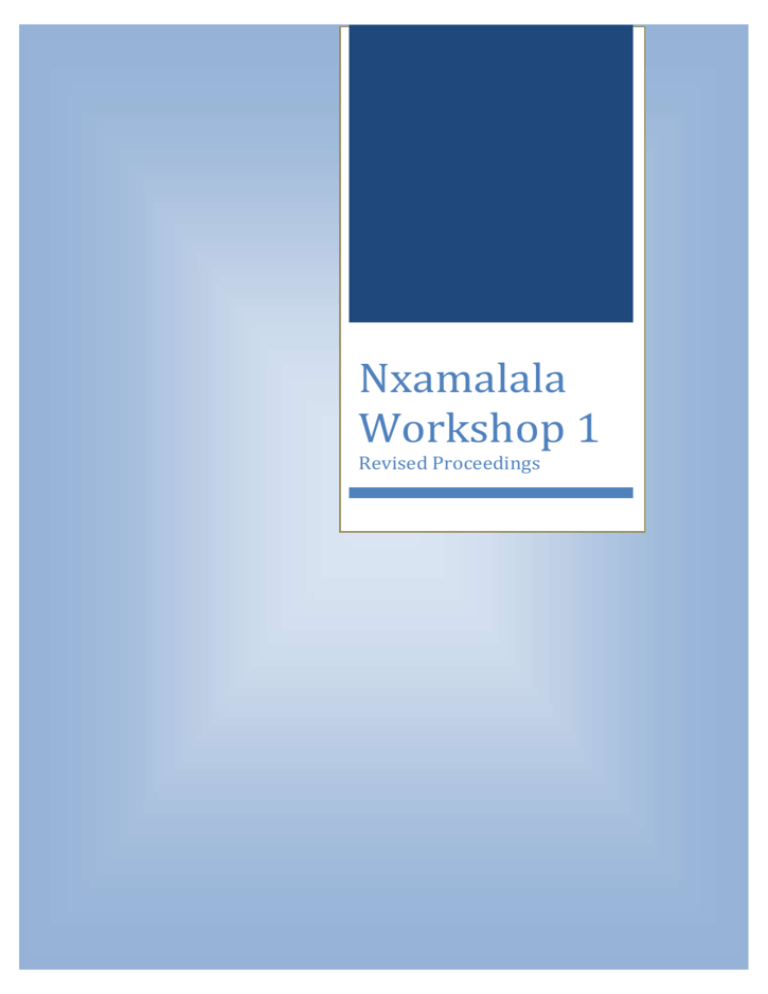
Nxamalala Workshop 1 Revised Proceedings 1 Workshop 1, conducted by Umphilo waManzi, in the Umngeni catchment (Howick Municipality) 07 December 2013 Objectives of the workshop To engage the Nxamalala community to build local understanding of climate change and its possible local impacts, particularly on water supply and agriculture. To explore “what does this mean for us?” To create a forum in which existing climate change adaptation strategies could be identified. To facilitate the formulation of an appropriate action plan. To strengthen connections between community groups and other stakeholders. Description of the area The Nxamala farm consists of 182 hectares of land located adjacent to the Fowler Farm in Howick. It falls under uMngeni municipality, and the uMngeni River passes through the area flowing into Midmar dam. A community-owned sawmill and a primary school for 85 children form part of Nxamalala. Many of the community members work at the sawmill, while some have worked at Fowler Farm, and others are employed on chicken farms or in woodworking. However, at the time of the workshops, it was reported that those working at the farm had had their employment contracts terminated. The workshop was supposed to be facilitated at the primary school but due to logistical problems, it was conducted at the saw-mill site. The site is also a place of residence, saw-mill workers have constructed wooden cabin houses using some of the waste timber they produce. The community gets its water from Howick municipality which is delivered to them by a truck; the water is stored in 200 liter plastic tanks. One of the community leaders is, however, concerned about the cleanliness of the water coming from the tank as it is smelly and sometimes develops some sticky substance (sludge). Although they purify the water using chemicals like JIK, the community leader said that other community members don’t like the smell of JIK in their drinking water. The other sources of water that were identified were a small stream that flows below the saw-mill site into a dam, and a stream which arises from a spring and flows into a marshy area/wetland, between the road and Nxamalala farm. Vulnerability and areas of action Concern over land tenure – the community does not yet have titledeeds to their land Unsafe water supply (smelly and muddy water from a nearby dam) Unemployment (due to retrenchments of farm workers) Health risks due to burning of coal for heat Food insecurity, the community lacks money to buy seeds and fertilizer to start community gardens Polluted dam from effluents coming from neighbouring farms upstream Vegetables grown at the sawmill need to be protected against being eaten by rats, which would also pose a health hazard to residents The water pooling at the sawmill is a drowning hazard for toddlers, and potentially a mosquito breeding ground in summer NXAMALALA WORKSHOP 1 2 Mapping the community’s assets Responding and adapting to climate change also requires the community to be fully aware of its resources and assets. The workshop facilitators identified the following community assets on their transect walk: Potential for private ownership of land Tanks for storing water School Borehole for water supply Regular municipal supply of water (sourced from Midmar Dam) Cell phone to call the municipality to supply water Plantation Dam Saw dust for compost and for chicken breeding Employment generated by the sawmill Forklift operating skill Waste timber on hand for recylcling/upcycling Introductions and Expectations The workshop began by inviting participants to introduce themselves (where they come from, what they do) and share what they hoped to gain from the workshop. Participants came from a wide range of places which included Fakuthi, Matatiela, Mzimkhulu and as far as Eastern Cape and Zimbabwe. Most of the participants reported that they migrated to Nxamalala in search of employment. The community was keen to learn about the sources of water, share information of how to effectively use water and land for growing food. They further expected to get some advice on how to fertilize the soil, acquire seeds and whether tank water that smells is safe to use on plants under cultivation. Some community members hoped for the workshop to provide them with information on how to grow their own crops and vegetables as a strategy to minimize food security. It appeared that some participants had first-hand experience of farming as they used to cultivate crops whilst growing up. A woman from Zimbabwe narrated that back she grows mielies and potatoes in her home country. 1.) Introduction to Climate Change Presentation NXAMALALA WORKSHOP 1 3 Objectives: - To provide information on what climate change is - To raise awareness around potential local impacts; encourage people to start thinking, before an extreme event, about how they might react. Activity: Mary Galvin gave a verbal presentation on the causes of global climate change in English, while Ma Khumalo translated into isiZulu. She discussed the processes leading to the buildup of Carbon in the atmosphere, and the climate change impacts that are evidenced in increasingly frequent extreme weather phenomena such as droughts and floods. Mary concluded her presentation by emphasizing that by sharing this information with the community, we were inviting them to think of how they would react to climate change in the future, for example, when heavy rains make it difficult to pass through the area, and encouraging them to start responding now. Outcomes and Reflections: Mr Ngcobo discussed how the community had altered its former practice of burning waste timber, and now called ‘shavings’ people to make shavings with it for use in chicken coops. Ngcobo mentioned that there was ill-feeling around this, as selected people were benefitting from the recycling of the waste, which is a collective resource. Further, he discussed the current requirement by the Department of Agriculture that the community-run sawmill request specific permission for burning. This has been extended to the use of the kiln, which has forced the sawmill to stack and airdry the timber they process, before selling it on. This is time consuming, and has negative cost implications. 2.) Climate Timeline mapping Objectives: -To Record weather patterns/incidences as experienced over a period of around thirty years (if possible) by residents in the area; -To make explicit community responses to problematic weather phenomena Activity: Facilitators engaged the community in a climate timeline mapping exercise. Community members were asked to reflect on the major weather events that have occurred over the past 30 years. The climate timeline map covered a period of almost 30 years beginning from 1985 to present. A big sheet of white paper was put up on the wall, on which Robinson recorded the identified events, which were detailed as follows: 1987: Floods that washed away houses 1990: Hail storm that destroyed crops NXAMALALA WORKSHOP 1 4 1998: Floods that killed two people 2009: Drying up of uMngeni dam 2009: Floods that affected the pine trees Outcomes and Reflections: Few participants had been located in Nxamalala for long enough to know a history dating beyond a few years. Much of what was reported was hearsay. There were only one or two incidents recounted where events, and community impacts and responses, could be described in any detail. Information gathered seemed sketchy and not continuous. The climate timeline was an important exercise as it allowed the workshop facilitators and participants to gain insight into weather extremes that the community had experienced. Umphilo’s hope was twofold: that by the community articulating their experiences of weather phenomena (that were possibly indicative of climate change at work) it raised their awareness of climate change and brought it into the realm of conscious thinking; and that by bringing to mind their responses, it emphasized the possibility for reflecting on ways of developing the most effective responses, which could involve adaptation and forward planning. 3.) The water cycle and catchment Objectives: - To introduce participants to how the water cycle works - To invite discussion on the water catchment areas that surround the community Activity: Water cycles handouts were distributed among the participants. The water cycle was also presented through power point slides. The facilitator explained each stage of the cycle emphasizing the notion that “water is never lost”. In exploring the local water catchment, one volunteer was asked to draw a sketch map of the catchment area. The volunteer succeeded in sketching out the catchment map capturing the flow of UMngeni River and Midmar dam. The sketch matched that of the map of uMngeni catchment that was retrieved from Google maps. Outcomes and Reflections: Participants appeared to have a sound understanding of the water cycle and they are aware of water sources in the areas. They mentioned Umngeni river and Midmar dam as important water sources. However, they also expressed concern around interruptions in tanker top-ups, and described periods when they had no tank water, and were forced to rely on unpurified dam/stream water for drinking. They mentioned previous outbreaks of cholera in their community as a compelling reason for ensuring a reliable supply of safe drinking water. 4.) DVD: Water harvesting/Permaculture NXAMALALA WORKSHOP 1 5 Objectives: - To introduce the community to alternative ways of food growing, with the emphasis on innovative use of water as a finite (often scarce) resource. Activity: A DVD on rain water harvesting was screened for the community via a DVD player. Outcomes: Participants were curious to know more about the dripping irrigation technique, where perforated plastic bottles submerged in heaped soil are used for irrigation. They also wanted to know how rain water could be harvested from the ground and fed into tanks buried under the ground. Generally, participants were thrilled by the DVD; they felt empowered about learning new methods of harvesting rain water. A sense of urgency was stimulated by the DVD, the community felt motivated to start food gardens and practice the dripping irrigation when they returned to their respective homes. 5.) Evaluation of the Workshop Participants were unanimous that the workshop was helpful and motivating. Some of the feedback received when asked to expand on: “What was useful to me today; What was my least favourite thing” ‘We knew what you were talking about [weather changes/climate change] but because we were looking for work and job and someone to pay us and help us to survive, we just pushed it away, but now that you are coming here and reminding us about these issues, we believe that it is important that we notice what is happening around us and start growing the food’ ‘It was amazing - the information helped a lot. We will spread the word for the next workshop’. ‘Are you going to come to our area in Matatiele? We need this in our area’. ‘I was amazed at the watering technique we saw in the DVD, where plastic bottles can be used for irrigation’. ‘I was surprised that water mixed with chillies can be used as an insecticide’. Some information we didn’t know about. It was helpful. There is nothing that was ‘worst’ – we never thought we would get such information. 6.) Plans for a Second Workshop NXAMALALA WORKSHOP 1 6 Participants were eager to attend the follow-up workshop in which they hoped to learn more about agriculture, particularly from experts. The formulation of action plans to cope with climate change were left for this second workshop, the date of which was set for the 2nd February 2014, after the long Christmas holiday. The agreed venue was the Corrie Lyn Primary school. Umphilo waManzi promised to invite other experts specializing in agriculture and community gardening to the workshop to respond to some of the farming questions raised by the participants. Bonginkosi indicated that he would again be willing to make the necessary arrangements in the area for the workshop. 7.) Umphilo reflections The Umphilo team was concerned that there seemed to be a boycott of the workshop by residents on the Nxamalala farm, with the exception of a schoolgirl, and four men who arrived for the start, and then left after the introductions. Discussions between Ma Khumalo and other women participants revealed that there was mistrust between this community and Mr Shabalala who had initiated the engagement. We took a decision to visit the community again before the second workshop, and spend time going door to door at the Nxamalala farm, to introduce ourselves and personally inviting individual householders to attend the following workshop (thus demonstrating our independence from Mr Shabalala – it transpired the men had attended as a lookout for Mr Shabalala, with the intention of chasing him if he arrived). NXAMALALA WORKSHOP 1
